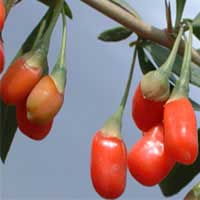 Full List of Fruits
Full List of Fruits  Wolfberry fruit
Wolfberry fruitWolfberry fruit
![]() Introduction of Wolfberry fruit
Introduction of Wolfberry fruit
Scientific name - Symphoricarpos occidentalis
Symphoricarpos occidentalis commonly known as wolfberry is found in the South of China, the species are categorized under the deciduous timbered perennial plants. The leaves form on the main stock of the plant, either in a sporadic arrangement or in bundles of up to three, each having either a narrow oval shape tapering to a point at each end (which is spearhead longer than the width) or ovate (egg-like) shape. Coming to the magnitude of the leaf, with less sharp or rounded tips, they are 7.0 cm wide by 3.5 cm broad. In the leaf axils, the flowers grow in groups of one to three.
Based on the climate, altitude and latitude, maturation will take place between the periods of August to October, on the other hand, in the Northern Hemisphere, flowering crops up from June through September. The tree produces a bright orange-red, ellipsoid berry that is 1-2 cm in diameter. Somewhere between July to October, the ripening will take place with regards to the Northern Hemisphere. Seeds present inside the fruit vary widely depending on several factors like cultivar and fruit size. Compacted with a curved embryo, in general, they contain 10-60 tiny yellow seeds.
![]() Nutritional Value of Wolfberry fruit
Nutritional Value of Wolfberry fruit
| Calcium | 112 mg, providing about 8-10% of the dietary reference intake (DRI) |
| Potassium | 1,132 mg, giving about 24% of the DRI |
| Iron | 9 mg (100% DRI) |
| Zinc | 2 mg (18% DRI) |
| Selenium | 50 micrograms (91% DRI) |
| Riboflavin (vitamin B2) | 1.3 mg, 100% of DRI |
| Vitamin C | 29 to 148 mg (respectively, 32% and 163% DRI) |
![]() Health Benefits of Wolfberry fruit
Health Benefits of Wolfberry fruit
Wolfberries are known for its healing properties, in china they are one of the most important traditional medicines which have been used since prehistoric times as general tonic to
 Protect the liver
Protect the liver
 Improve eye sight
Improve eye sight
 Strengthen weak legs and to promote longevity
Strengthen weak legs and to promote longevity
While the leaves are used to prepare tea, the root bark is used as a medicine to treat inflammatory skin disease. Seeing that, the fruits contain phytochemicals with antioxidant activity; this action helps to slow down the ageing process. In addition, they are said to help prevent oxidation of DNA which further helps to restore damaged DNA. The extract helps slow up DNA metamorphosis and stop the intensification of cancer cells. Moreover, they are also used as a traditional medicine to improve visions deficiency including cataracts, retinopathy and macular degeneration. Having said all that, in some people wolfberry is said to show some warnings, hence it is a must to be aware of the side effects it brings in as well.
![]() Wolfberry Side Effects and Warnings
Wolfberry Side Effects and Warnings
 For most people, it is considered safe when taken by mouth.
For most people, it is considered safe when taken by mouth.
 It contains a compound called betaine which makes them unsafe for pregnant and breast feeding women.
It contains a compound called betaine which makes them unsafe for pregnant and breast feeding women.
 They may cause minor side effects such as nausea and vomiting.
They may cause minor side effects such as nausea and vomiting.
 Seeing that wolfberry has lowering effects on blood pressure and blood sugar levels, it can complex other medications taken to lower blood pressure and diabetes.
Seeing that wolfberry has lowering effects on blood pressure and blood sugar levels, it can complex other medications taken to lower blood pressure and diabetes.
 The fruits interaction with warfarin, a blood thinning drug may cause bleeding side effects or bruising.
The fruits interaction with warfarin, a blood thinning drug may cause bleeding side effects or bruising.
It is during the late summer or early autumn, harvesting of wolfberries takes place. The harvested berries are then dried out in shade till the cortex is wrinkled totally. After this process, they are dried out in the sun until the fruit gets crusted, without letting the softness of the pulp go off. Harvesting during the spring is highly suggested; however the roots can be harvested anytime. It can be used either fresh or dried. Ningxia, Qinghai and Gansu are some of the regions, where the best wolfberries are produced. Every single part of the plant is highly valuable, not only the fruit is juicy, but their leaves are also very tender and edible. These berries are commonly identified with several other regional names such as Lycium Fruit, Matrimony Vine Fruit, Chinese Desert Thorn Fruit, Box Thorn Fruit and Chinese Wolfberry Fruit. Mild in nature, they are sweet to taste and the roots of the fruit is also used as medicine.


















